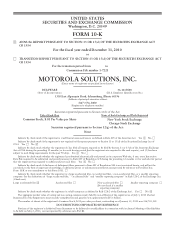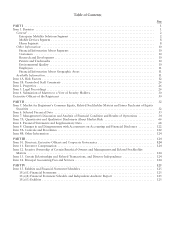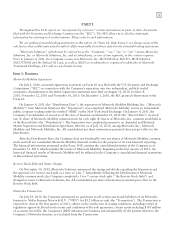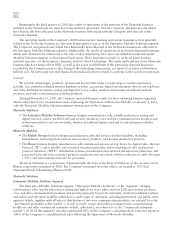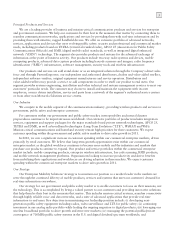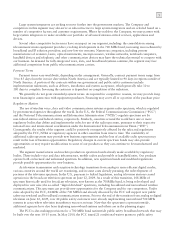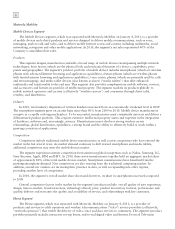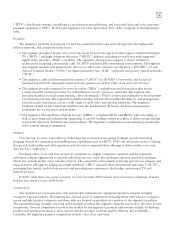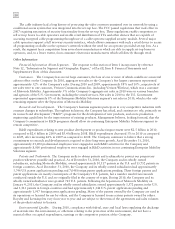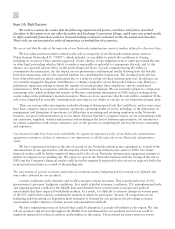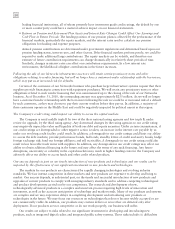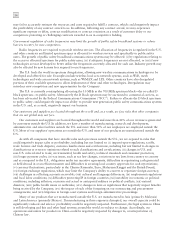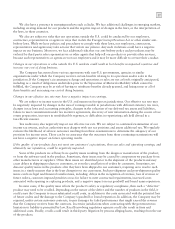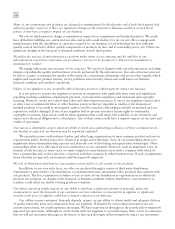Motorola 2010 Annual Report Download - page 16
Download and view the complete annual report
Please find page 16 of the 2010 Motorola annual report below. You can navigate through the pages in the report by either clicking on the pages listed below, or by using the keyword search tool below to find specific information within the annual report.
8
Motorola Mobility
Mobile Devices Segment
The Mobile Devices segment, which was separated with Motorola Mobility on January 4, 2011, is a provider
of mobile devices and related products and services designed to deliver mobile communications, such as voice,
messaging, push-to-talk and video, and to deliver mobile Internet access and content, including multimedia, social
networking, navigation and other mobile applications. In 2010, the segment’s net sales represented 40% of the
Company’s consolidated net sales.
Products
This segment designs, manufactures and sells a broad range of mobile devices encompassing multiple network
technologies, form factors (which are the physical look and mechanical function of a device), capabilities, price
points and geographies. The segment’s product portfolio of mobile devices includes smartphones (which are wireless
phones with advanced Internet browsing and application capabilities), feature-phones (which are wireless phones
with limited internet browsing and application capabilities), voice-centric phones (which are primarily used for calls
and text messaging), and media tablet devices (also known as slates) (“media tablets”) that offer enhanced
multimedia and functionality to the end user. This segment also provides complementary mobile software, services,
and accessories and licenses its portfolio of intellectual property. The segment markets its products globally to
mobile network operators and carriers (collectively “wireless carriers”) and consumers through direct sales,
retailers, and distributors.
Industry
In 2010, total industry shipments of wireless handsets increased from an economically weakened level in 2009.
The smartphone segment grew on an unit basis more than 60% from 2009 to 2010. Mobile device manufacturers
compete in a rapidly evolving marketplace. To be successful, manufacturers must consistently innovate and deliver a
differentiated product portfolio. This requires extensive intellectual property assets and expertise in the integration
of hardware, software and, increasingly, services. Manufacturers must also have strong wireless carrier
relationships, global distribution capabilities, a strong brand and the ability to effectively build or work within a
growing ecosystem of applications.
Competition
Competitors include traditional mobile device manufacturers as well as new competitors who have entered the
market in the last several years. As market demand continues to shift toward smartphones and media tablets,
additional competitors may enter the mobile devices market.
The segment experiences intense competition from numerous global competitors such as Nokia, Samsung, LG,
Sony-Ericsson, Apple, RIM and HTC. In 2010, these seven manufacturers together held an aggregate market share
of approximately 80% of the total mobile devices market. Smartphone manufacturers have benefited from the
growing smartphone demand. New competitors are also entering from the traditional computing market. In
addition, second-tier vendors are increasing their presence in Asia, as well as expanding into other regions,
providing another layer of competition.
In 2010, the segment’s overall market share decreased; however, its share in smartphones increased compared
to 2009.
General competitive factors in the market for the segment’s products include: overall quality of user experience;
design; time-to-market; brand awareness; technology offered; price; product innovation, features, performance and
quality; delivery and warranty; the quality and availability of service; and relationships with key customers.
Home Segment
The Home segment, which was separated with Motorola Mobility on January 4, 2011, is a provider of
products and services to cable operators and wireline telecommunications (“telco”) service providers (collectively,
“network operators”) that enable the delivery of video, voice and data services to consumers. The segment’s product
portfolio primarily includes interactive set-top boxes, end-to-end digital video and Internet Protocol Television



